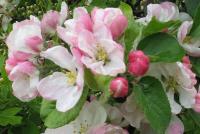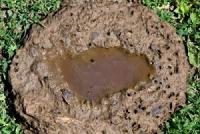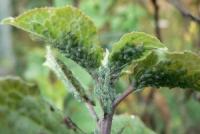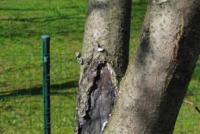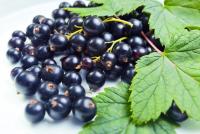Green bugs on an apple tree how to fight. How to protect the trees from the codling moth. The main pests of apple trees
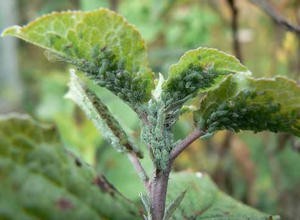
The main signs of damage to the apple: leaves curl, dry and fall off, covered with bloom or mold, the bark changes, the tree withers. Proper handling and spraying, competent care will help you fight pests.
The main pests of apple trees are divided into two groups:
- Gnawing insects. Kidneys, leaves, flowers, shoots are amazing. These include barbel, May beetles, butterfly caterpillars, and weevil beetles.
- Sucking insects. They hit the tree and the leaves with the help of punctures, suck the vital juices of the apple tree. Such pests include aphids, scutum, mites and leaf sheets, cycadad, pennits.
To prevent their occurrence, provide proper care in early spring, summer and autumn.
Given the place of damage and influence, pests are divided into the following groups:
Full care includes carrying out sanitary, preventive pruning in the fall, in the spring. It is important to perform a thorough inspection of the tree in the fall so that no pests are left in the bark. To this end, in the fall pruning, whitewashing. In this case, the struggle will be more effective. Competent care will help you to fight with apple pests, harmful insects.
It is interesting! Pests of the apple tree are hares, mice and even cats, which use the trunk as a tool for sharpening their own claws.
Treatment methods
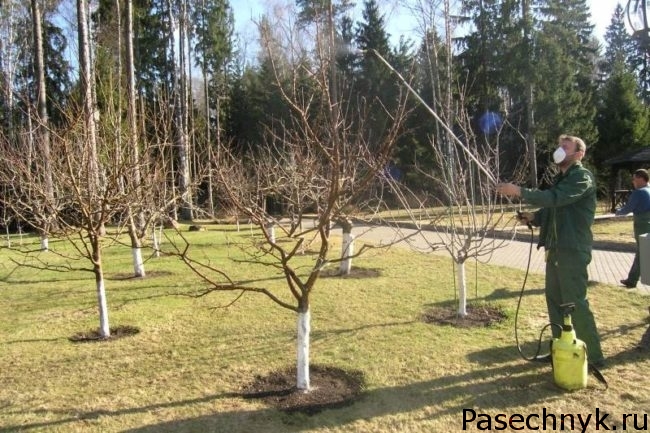
And also in the spring and summer period, includes a list of the main activities that must be carried out. One of them is prevention, treatment of diseases, elimination of pests. Most often, spraying is carried out with an appropriate solution. There are also some techniques with which it is desirable to become familiar.
Method 1. Mechanical:
- it is necessary to collect spider nests, scrape or crush the egg-laying;
- collect, burn the leaves dry;
- rinse off insects with a hose;
- shake pests on the film, the fabric to destroy;
- place special traps, such as pheromone;
- taking advantage of roofing material, lapnik, to build protection for the lower part of the tree from beavers, mice, rabbits;
- add 3% Creolin to mulch, use as a remedy for butterflies, aphids, ticks and the May beetle.
Method 2. Chemical. Spray the tree until flowering, and also before winter:
- spring processing - 0.8% karbofos and 0.2% metaphos (solutions);
- one percent drug DNOC;
- three percent nitrafen;
- ground, colloidal sulfur of 10 percent;
- finished products - Spark and Decis, Aktelik;
- spraying with iron sulphate or liquid Bordeaux 3%.
Method 3. Biological. Creates the right conditions to attract a natural pest:
- reduce the activity of garden ants;
- in the cold season to attract birds using feeders;
- place artificial nests.
Method 4. Agrotechnical:
- trimming;
- proper care;
- spraying of blue vitriol;
- loosening of the wheel circle to a depth of fifteen centimeters;
- thick mulch;
- watering;
- fertilization.
Method 5. Folk:
- spraying a twenty percent soap solution;
- from aphids helps tobacco broth;
- fumigation;
- ash broth is treated shtamb.
The appearance of such pests becomes fatal in the event that there is a proliferation of a huge population. It is important to determine in time the presence of the enemy and eliminate it, to provide the tree with professional care and protection.
Not every gardener can grow a good apple orchard, because for this it is necessary to spend a lot of effort, time and certain skills and knowledge. In addition, diseases and pests of apple trees cause enormous damage to fruit trees, due to which their productivity is reduced and their health deteriorates.
If we determine in time the presence of harmful insects, the plants can be saved without resorting to drastic measures of control. In the garden you can find a lot of insects that are not averse to eat leaves, shoots, flowers and bark of fruit trees. Most of them appear annually, destroy the aboveground part of plants and their fruits. Apple pest control should be carried out regularly and in a timely manner.
Apple Pests - Descriptions and Photos
 The most avid pest of a fruit tree, which can be found on fruit trees in any region. This pest settles in whole columns on the foliage, stalks, exterminating all the green mass in the trees. Damaged aphids places are covered with a specific patina.
The most avid pest of a fruit tree, which can be found on fruit trees in any region. This pest settles in whole columns on the foliage, stalks, exterminating all the green mass in the trees. Damaged aphids places are covered with a specific patina.
The ladybugs are the only insects that can exterminate this pest. Since not everyone succeeds in getting these insects in large numbers, gardeners treat damaged plants with Karbofos or tobacco-soap solution.
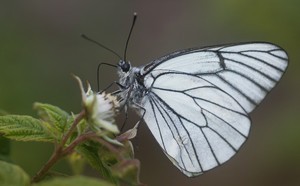 It is a large white-winged day moth. Her offspring eats leaves and flowers of the apple tree. In the middle of summer, they pupate and transform into butterflies. One female can reproduce up to half a thousand eggs, from which caterpillars appear.
It is a large white-winged day moth. Her offspring eats leaves and flowers of the apple tree. In the middle of summer, they pupate and transform into butterflies. One female can reproduce up to half a thousand eggs, from which caterpillars appear.
In the spring, apple trees from hawthorn are treated with insecticides - Chlorophos, Karbofos, Metaphos, Zolon or Phosphamide. In the autumn, when the harvest of the fruit is gathered, the caterpillars, along with the twisted leaves, are shaken off onto the canvas spread under the tree. Hawthorn loves to eat pollen from flowering weeds. Therefore, in a clean garden the probability of occurrence of this pest is reduced.
The fight with butterflies is carried out before the start of bud break. Trees are treated with Nitrafen or Olekuprit. To destroy the caterpillars, you need to spray the crown of plants before they bloom, with insecticides or fungicides according to the instructions.
These are microscopic insects that mainly focus on the tips of the shoots and leaves. Preventive measures include the annual cleaning of trees from the old bark and its complete destruction. In addition, trees are treated in the spring with Karbofos or Dicofol, previously diluted with water.
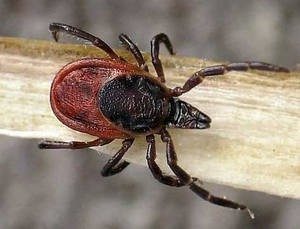 Small larvae of this pest appear during the growing season and begin to shed, leaving behind a grayish bloom.
Small larvae of this pest appear during the growing season and begin to shed, leaving behind a grayish bloom.
Three weeks later, adult individuals of brownish hue appear from the larvae, which lay eggs on the foliage and stalks of the apple trees. To get rid of the brown mite, the plants irrigate with acaricides at the initial stage of flowering and in the summer one month before harvesting.
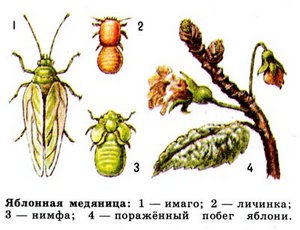 These are microscopic insects of salad or yellowish color that damage young leaves and buds on trees.
These are microscopic insects of salad or yellowish color that damage young leaves and buds on trees.
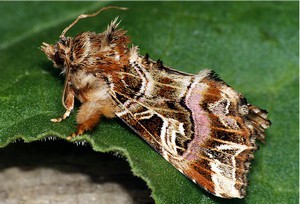 Its larvae are caterpillars that successfully hibernate in the bark of apple trees. In spring, when the growing season begins in plants, they crawl out and settle on the foliage.
Its larvae are caterpillars that successfully hibernate in the bark of apple trees. In spring, when the growing season begins in plants, they crawl out and settle on the foliage.
These insects feed on leaves with shoots of trees, making numerous passages in them. In this place they pupate and envelop the leaves with a thin web. The new generation continues to destroy the aboveground part of the plants. Damaged specimens should be sprayed with Chlorofos or Zolon. It is necessary to destroy the caterpillars along with the nests.
 One of the most common pests that can be found in every garden. It infects the leaves, young shoots, stems, buds, pulls leaves with cobwebs, and then pupates them.
One of the most common pests that can be found in every garden. It infects the leaves, young shoots, stems, buds, pulls leaves with cobwebs, and then pupates them.
The struggle with the leafworm is carried out in the spring, when young leaves appear on the crowns of plants and insects by this time have time to get over them. The plants are treated with Nitrofen solution of 3% concentration prior to the beginning of the growing season. After the buds bloom, a second treatment with Chlorophos solution is performed.
Pear sawfly
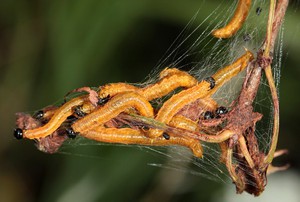 The small size of the beetle is red with a black head and transparent wings in a dark stripe. The larvae of this pest are caterpillars of orange or yellow color, which feed on sap from leaf tissues. The offspring pupates into coiled leaves wrapped in a tubule.
The small size of the beetle is red with a black head and transparent wings in a dark stripe. The larvae of this pest are caterpillars of orange or yellow color, which feed on sap from leaf tissues. The offspring pupates into coiled leaves wrapped in a tubule.
With a massive destruction of all the foliage on the tree can be completely destroyed. Infected specimens are treated with insecticides - Aktellik, Chlorofos, Karbofos or Phosphamide. All folded leaves with spider nests are removed and burned.
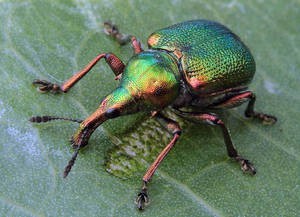 Or, as it is also called, weevil, which causes enormous damage to fruit trees, including apple trees, is a beetle, bright green or dark blue, up to 10 mm long.
Or, as it is also called, weevil, which causes enormous damage to fruit trees, including apple trees, is a beetle, bright green or dark blue, up to 10 mm long.
Tubkovert easily transfers wintering, dwelling in the bark of the trunk, fallen leaves or in the soil. Females lay eggs in folded leaves, which later eat the hatched larvae.
The fight against pear pipe-drawing is carried out by the method of repeated spraying with chemical preparations - Gardona, Corsara, Actellic or Waterfox. Also for the extermination of this pest treatment is carried out with insecticides. For the purpose of prophylaxis, in the fall they produce a deep digging of the soil around the tree trunk.
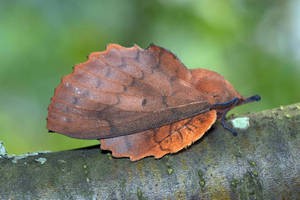 This is a large moth with brown wings. Its caterpillars feed on the leaves and buds of young saplings. They hibernate in the hollows of the bark and in other secluded places of the crown.
This is a large moth with brown wings. Its caterpillars feed on the leaves and buds of young saplings. They hibernate in the hollows of the bark and in other secluded places of the crown.
The silkworm female lays eggs one by one on the foliage. Two weeks later, gray larvae appear from them. They eat the leaves, gnawing out moves on their surface. In the fall, with the onset of cold weather, insects go to winter.
Methods of control: severely affected specimens are treated with chemicals - Karbofos, Metatin, Zolon, Phosphamide, or Nexion. In order to prevent the need for frequent inspections of plants in spring and autumn, for the presence of harmful insects. When not significant settlement of the offspring of the silkworm is harvested by hand.
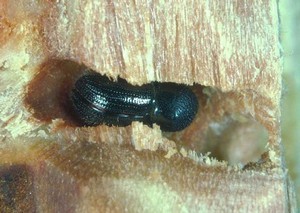 These are beetles of dark-brown color up to 5 mm long, damaging the bark of the trunks and stems in adult and young plants. The female lays eggs, from which legless, white-colored larvae hatch, which winter in the recesses of wood and tree bark. Strongly infected fruit trees rot and weaken, cease to bear fruit.
These are beetles of dark-brown color up to 5 mm long, damaging the bark of the trunks and stems in adult and young plants. The female lays eggs, from which legless, white-colored larvae hatch, which winter in the recesses of wood and tree bark. Strongly infected fruit trees rot and weaken, cease to bear fruit.
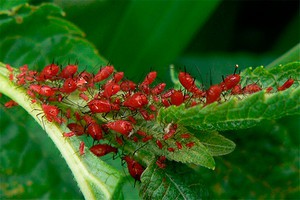 This harmful insect sucks the juice from young leaves, stems, shoots and buds. Subsequently, on the affected places appear sores pink.
This harmful insect sucks the juice from young leaves, stems, shoots and buds. Subsequently, on the affected places appear sores pink.
In case of severe damage, the plants lose their decorative effect, poorly bear fruit and die as a result. You can notice the presence of blood aphids in early spring, when buds bloom. Microscopic larvae, in appearance, resembling adult individuals, massively settle on the buds and young foliage. In June, females appear, which are the hawkers and distributors of these insects throughout the garden.
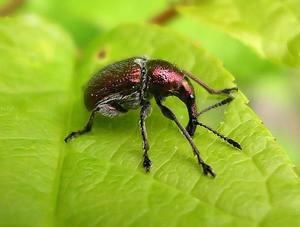 Weevil beetle up to 7 cm long. This pest is a great danger to future harvest. First, he destroys the vegetative buds, then infiltrates into the immature fruits and gnaws them from the inside.
Weevil beetle up to 7 cm long. This pest is a great danger to future harvest. First, he destroys the vegetative buds, then infiltrates into the immature fruits and gnaws them from the inside.
The offspring of geese can live inside the fruit for about a month, after which they leave for the soil. There they pupate. The pupae are transformed into beetles. Some insects remain in the soil, while others rise to the surface and exterminate the fruit buds of apple and other fruit trees.
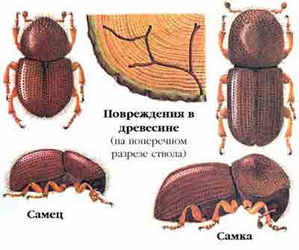 It is a beetle up to 4 mm long in brown color, destroying the bark and wood of apple trees. Bark beetle likes to feast on the bark of both adult trees and young seedlings. Its white larvae feed on young foliage.
It is a beetle up to 4 mm long in brown color, destroying the bark and wood of apple trees. Bark beetle likes to feast on the bark of both adult trees and young seedlings. Its white larvae feed on young foliage.
To destroy this pest it is necessary to carry out repeated treatment of trees with Trichlorol-5, starting from the moment of bud swelling and until the end of flowering. When the beetle leaves the bark, additional processing of the crown with Chlorophos or Metaphos is carried out. Repeated treatment with these preparations is carried out in case bark beetles are distributed throughout the site.
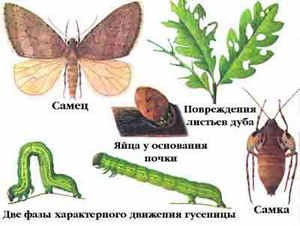 This pest appears in late autumn, when almost all other insects go for the winter.
This pest appears in late autumn, when almost all other insects go for the winter.
The butterfly of the winter moth damages the entire above-ground part of the fruit plantations - foliage, flower buds, buds and stems. Females lay their eggs in cracks in the bark and branches. One individual can lay up to three hundred eggs. In the spring, when the apple trees bloom, the new generation crawls out of cracks and destroys everything in its path - leaves, flowers and young shoots. After the trees ottsvetut, they descend into the soil to a depth of 15 cm, there they also pupate. In the middle of the autumn begins the years of the winter moth butterflies.
Exterminate the winter moth is quite difficult. For this purpose, repeated treatment of crowns with insecticides is carried out. After that, the soil is digging in order to destroy the pupae larvae larvae. In addition, in the fall, after harvesting, trapping belts are attached to tree trunks. Such devices do not allow females to get to the tree crown. As a result, the laying of eggs occurs in the lower part of the trunk, where they can be easily found and destroyed.
Ringed silkworm
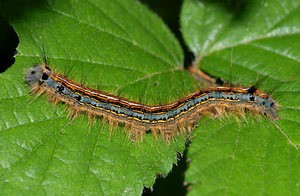 Nocturnal moth, the larvae of which eats foliage and young buds of fruit trees, including apple trees.
Nocturnal moth, the larvae of which eats foliage and young buds of fruit trees, including apple trees.
Caterpillars settle on crowns in large colonies, very easily spread by the wind. Wintering these insects carry under the shell of eggs. In the spring, as soon as the heat comes, they go outside and feed on vegetative buds and young foliage. Irrigation of heavily infected specimens is carried out with chemicals. In rare cases, the stalks with eggs are cut and destroyed.
Prior to the beginning of the growing season, the emergence of a silkworm can be prevented by irrigating trees with Olekuprit or Nitrafen. After flowering, an inspection of the trees for the presence of silkworm web nests is conducted. They are removed in the morning, when the caterpillars have not yet managed to spread.
Moli miners
Small apple butterfly, which causes great harm to fruit plantations, especially apples. The caterpillars of this insect gnaw out the passages in the leaf tissues, while not damaging the integrity of the leaf plate.
In early spring, when buds have not yet awakened in the trees, the crown is irrigated with the drug Nitrafen. To avoid subsequent infection, in the fall it is necessary to clear the garden of fallen leaves and make digging the soil around the trees.
Many gardeners with great success use the infusion of bitter pepper in the fight against this pest. 1 kg of fresh peppers is poured with a bucket of water, boiled for an hour, then left for a day. 100 g of the finished concentrate is brought to a volume of 10 liters with water and a couple of tablespoons of chopped laundry soap are added. Processing plants is carried out 3 times with a frequency of 1 time every two weeks.
Pests during apple blossoms
At each stage of apple growth can be affected by different pests. Some insects appear only during the flowering period of the trees - this is a fruit grass and apple flowering beetle.
Pests continuously produce eggs on the fruits and leaves of trees throughout the month. Three weeks later, caterpillars emerge from the eggs, which intensively destroy the fruits from the inside.
The control of pests on apple trees with fruit trees is rather complicated, since these insects are located inside the fruit. First of all, it is necessary to remove from the site all damaged apples. In addition, carry out additional measures:
- cleaning the old bark;
- disinfection of the trunk of apple trees.
The treatment of diseased plantations is carried out with preparations of Karbofos or Chlorofos.
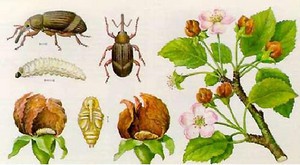 It is a beetle with light stripes on its shell and a curved proboscis. This insect tolerates hibernation under fallen leaves or in the bark of trees. In early spring, the flowering bee wakes up, climbs up the tree and eats the vegetative buds of the plant.
It is a beetle with light stripes on its shell and a curved proboscis. This insect tolerates hibernation under fallen leaves or in the bark of trees. In early spring, the flowering bee wakes up, climbs up the tree and eats the vegetative buds of the plant.
The female beetle settles on flower buds and lays eggs in this place. The offspring born into the world eat flowers from the inside. All this adversely affects the yield of apple trees. Adult insects shake off the shield and manually destroyed. After that, the tree is sprayed with a 0.3% concentrate of Chlorophos or Karbofos.
Apple diseases and pests are a real problem in a neglected and uncultivated garden. With the observance of all the conditions of agrotechnology of this culture, the creation of optimal conditions for growth, development and fruiting, these problems can be avoided.
Green Apple Aphid
This insect has a length of 1.2 to 3 mm. His body has a yellow-green color. The insect lays eggs of black color, which have a length of 0.5 mm, on favorite places. These are young branches, places near the buds, especially parts of plants that grew last year. Larvae hatch in spring. First, they are on the kidneys, then penetrate them, from where they are almost impossible to get.
During the season, aphids hatch up to 6 generations in cold places and up to 16 in especially warm ones. Some insects hunt it, for example, the "cinderbug", the larvae of flies and golden-eyed flies. The aphids and riders destroy the larvae of which settle in her body.
How to fight? Before the tree dissolved buds in early spring, it must be treated with nitrophene, the solution of which is prepared according to the recipe: 20 g per liter of water. Thanks to this substance, the eggs that remain after the winter die. In addition to trees, the soil in the gardens is subject to treatment. In addition to nitrophene, you can use KZM (green oil concentrate), which is added 60-80 g per liter. When aphid infects trees in the summer, they are sprayed with tobacco infusion.
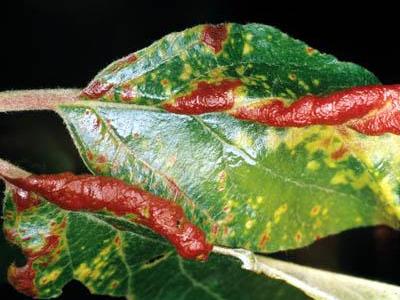
Red Apple Apple Aphid
By June, females-settlers and males that have wings appear, as well as females, the purpose of which is to lay eggs. They do not have wings. And at the end of this month, when many leaves and shoots of apple trees stop growing, these insects move closer to the bark in which they lay eggs. The leaves are yellow and red spots, swellings, they are twisted longitudinally. Struggling with a red-gable aphid as well as with a green one.
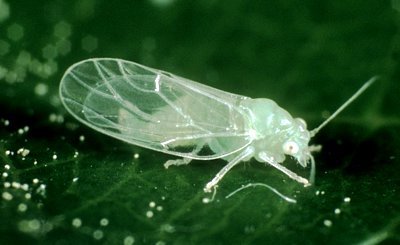
Apple Copper
Insect larvae begin their activity with the beginning of spring. Then they begin to harm the kidneys, and later the leaves and flowers. The insect feeds on plant sap, causing them to curl leaves, stop flowering, lose color, die off and crumble. The characteristic “handwriting” of the brawl is “honeydew”. This is the so-called insect excretion, which contain a lot of sugar. Shoots, leaves and flowers are contaminated by them, attracting ants. And after them the fungus comes to this place. They are fighting with a sucker in the same way as with the above types of aphids.
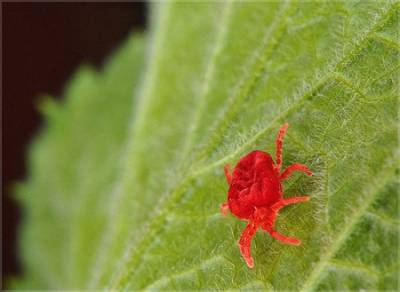
Red Apple Tick
Red apple mite is found in the North and at the Center for Horticultural Areas. The body of the insect has an oval appearance and a length of 0.6 mm. He lays eggs under the bark, near the buds and in the forks of the branches. The color of the eggs collected in groups, orange-red. Before flowering or during it, the larvae hatch from the eggs, which creep out on the edge of the leaves. Over time, they cover the edges of the leaves so much that they turn red. After half a month, adult ticks grow from the larvae.
How to deal with it? Trees affected by ticks and their eggs require treatment with DNOC, which is sprayed the garden until the time when the buds blossom. 10 g of the drug are taken per liter of water. There is another option - the emulsion of mineral oils. Take the drug number 30 and diluted with water to 50 g of one liter. But here we must take into account that mineral oils slow down the growth of fruit trees. They can be used no more than once every three years. If the mite has planted a lot of larvae that appeared during budding and flowering, the tree is not yet bloomed, they are treated with solutions of carbofos 2-3 g, colloidal sulfur 10 g, Celtan 2 g or metaphos 2 g per liter of water.

Apple treeworm
The apple comma-like scapula lays white oval-shaped eggs for the winter in small groups. They are in the amount of from 50 to 120 pieces in the winter keeps the shield of the dead female. It has the form of a comma, a length of 0.3-0.4 cm and a brown color. After the apple tree blooms, the eggs give small larvae of a light yellow color. They begin to creep away from the scute until they reach the bark of young branches, to which they stick.
To defeat the invasion of the shchitov, you need a week later, after the apple trees have bloomed, spray them with a 0.15-0.2% solution of a metaphos or a 0.2-0.3% solution of karbofos. To eliminate eggs, you need to use a 2-3% solution of nitrofen or a 1% solution of DNOC, which is treated with trees before they have dissolved the buds.

Apple Moleworm
Insect - a butterfly of very small size, the distance between which is 1.2 cm. It occurs throughout the country. In the cracks of the bark in winter, you can find both caterpillars and butterflies. They can also winter under the leaves that lie on the ground. After winter, the surviving females lay about 10 eggs, placing them on the leaves. Later, the caterpillars turn into butterflies, which in summer again lay eggs in even larger quantities.
The caterpillar of the appleworm moth destroys leafy plates, leaving only the skeleton of the veins. First, the lower side is destroyed, and then the upper side. Between the leaves of the caterpillar make a move out of the web. Then they make cocoons into which they turn into pupae. They fix them near the central vein on the upper side of the leaf blade. In the north and in the center, the mole displays up to two generations a year, and in the south - up to three. It takes up to 1.5 months to breed one generation.
How to deal with moths? When the leafworm caterpillars hatch, the trees need to be treated with chlorofos by spraying liquid, at the rate of 10-20 g per 10 l. You can also take 30 grams of metaphos, 20-30 grams of karbofos or 20 grams of trichlormetaphos. Until the buds in the trees have blossomed, the caterpillars that survived the winter must be destroyed by treating the tree with a KZM solution, spreading 60-80 g of it in a liter of water. Little wisp destroy and with leaves, which fell down.
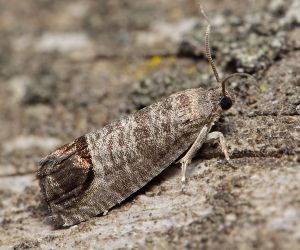
Codling moth
In the north, the moth displays one generation, and in the south - two. For the winter, the caterpillar moth larvae hide in old boxes, cracks of bark and soil, and also in cocoons. In the spring, butterflies climb out of these shelters for two months.
When the apple trees bloom, butterflies carry up to 180 eggs, which are located on the leaves, and when fruits appear, they are also on them. After two or three weeks, the caterpillars hatch from the eggs, which begin to hit the fruit, trying to reach the seed cells. Once there, they climb out of an apple, and crawl onto the next one, repeating there the whole way. Then the caterpillars prepare for cocooning. In the north, they fall into cocoons, and do not climb out until spring. The second and third generation bring the greatest harm. Moths destroy the early fruits of apple trees, which then fall and disappear.
How to deal with moth? In the north of Russia, early apple varieties are processed twice, and later ones - three times. The first time is treated 2-3 weeks after flowering, and repeated 10-12 days after the first treatment. For this purpose, chlorophos 80% is used, for the preparation of which 2 g of substance are added per liter of water. For the destruction of adult individuals moths use various devices, including electric and light-traps, baits with odorous liquid. To caterpillars were less, you need to install trap belts and collect the drop. When the buds are advanced, it is advised to treat them with ethnobacterin.
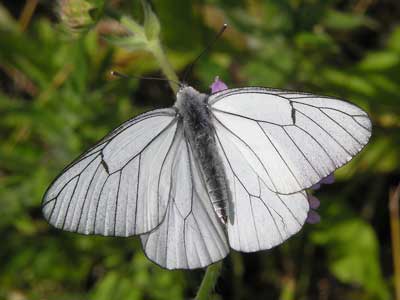
Hawthorn
The Hawthorn is a butterfly with large white wings, which can be found throughout July. Its characteristic feature - wings with black veins.
Its activity can be seen in the fall, when on leafless trees in some places there are leaves, which with the help of cobwebs are kept on them. In these homes, the small caterpillars of the Hawthorn survive the winter. In the spring, they begin to feed on the buds and leaves on the tree.
How to fight? In autumn and winter, you need to find such leaves, collect them and burn them. If the pest has hit the garden in large quantities, the latter needs to be treated with chlorophos 0.2%, for the preparation of which 20 grams of the substance and 10 liters of water are taken.
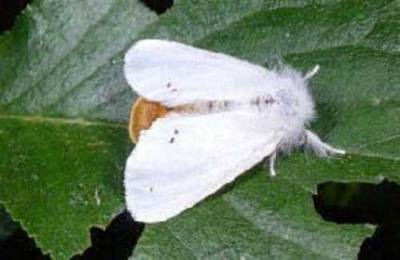
Zlatoguzka
White butterfly, nocturnal. The distance between the wings is 3.5 cm. The name of the insect comes from the thickening of the golden color on the abdomen. Caterpillars for the winter create nests of leaves and cobwebs. To create them, 7-8 leaves are used, which the caterpillar weaves around with a web like silk. In such a nest can winter around 200 individuals. The location of such nests is a fork and the ends of branches of small thickness.
Gypsy moth, he is a goldfinder, damages various sorts of apple trees. Under favorable conditions, the insect is able to destroy not only one branch or tree, but entire gardens and even forests. In the silkworm in one laying up to 600 eggs, which remain for the winter below the apple tree trunk or on the fence. The eggs are covered with light colored hairs. The buds are not yet blooming on the tree, as the caterpillars are already active. First, they destroy the buds, then switch to the leaves. Having destroyed a tree, they move to another, even if it is located in a nearby garden or forest. Caterpillars at a young age are rather light and hairy, so they can be transported up to 12 kilometers in the wind. When the caterpillars have received a sufficient amount of nutrients, they pupate in the previously formed cocoons or just near the leaves and bark. The butterfly flies and lays new eggs by July, at night.
How to deal with unpaired silkworm? Need to find and destroy eggs. Suitable for this oil products: kerosene, oil, engine oil. If the eggs are located on a thin bark, it is enough to remove the eggs and destroy. Before flowering trees need to be treated with a solution of chlorophos 0.2%.
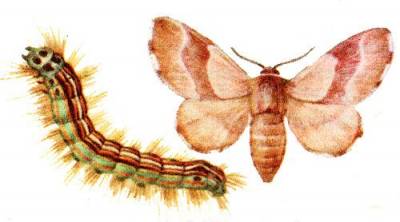
Corned silkworm
Butterfly, which is engaged in laying eggs for the winter on the shoots, which sticks together. As a result of the effect of the boron liquid emitted by it as a resin, annular masonry is obtained, in each of which up to 400 eggs are harvested by it in the winter.
Harm to the tree is brought by caterpillars, which begin to be active during the swelling and blooming of buds. Insect kills the buds and leaves, feeding on them for up to 40 days. After that, they form pupae in cocoons, of which butterflies appear in the middle of summer.
How to fight? It is necessary after the leaf fall to collect the leaves and destroy them along with the butterfly eggs. Find the tracks that stayed on the knots and destroy. When the tree is about to bloom, it will need to be treated with a 0.2% chlorophos solution.

Apple sawfly
Insect, which in developed form has a length of 0.6-0.7 cm, and resembles bees in appearance. The last stage of development in front of adults is experiencing winter in the soil. 3-5 days, before the early varieties of apple trees begin to bloom, the sawflies fly out and arrange egg-laying. In each flower, bud or perianth, they lay one egg. As a result, one female can lay up to 80 eggs.
Harm to the tree is done by the larvae, which are also called caterpillars. They have 10 pairs of limbs, their color is yellow-white, and they also have the ability to have a special odor. First, the larvae destroy the skin of the ovary, and then the fruit, destroying the seeds in them. One larva needs about four full fruits to get soaked. After a month of such feeding, the larvae enter the soil.
The difference between sawflies and moths is that they are only interested in the young ovary, in which they destroy the entire core, and not just a part of it.
The trees from the sawfly are processed only by those on which he met. Carbophos solution is sprayed, for the preparation of which 3 g of substance is taken per liter of water, or 2 g per liter of chlorophos. At first adult insects are destroyed. Carry out the operation seven days before flowering. Later, after flowering, the larvae are removed in the same way. It should be borne in mind that spraying should be done on time, because later you can kill useful insects. Also measures to combat sawfly include loosening and digging up the soil.
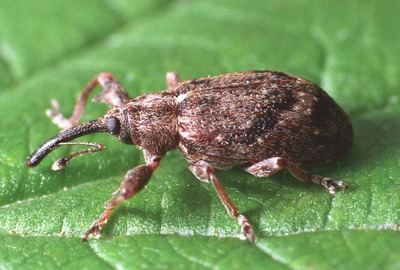
Apple Blossom
When the buds swell, the female puts eggs in them. When the larvae hatch from them, they eat the flower inside, causing it to die. The larva develops 2-3 weeks, turning into a pupa inside the flower. After a week and a half, a full-fledged beetle hatches from it. New individuals up to two weeks destroy the leaves, and then preserved in the soil for the winter. The most dangerous beetle provides buds.
How to fight? Before the buds have opened, in the spring you need to shake the tree several times and collect all the beetles on any surface: fabric, canvas or wooden. Then they are drowned in buckets of water. The ambient temperature should be no more than 10 degrees. When the buds open, the tree is treated with a 0.2% solution of chlorophos or metaphos.
You might be interested :
Getting high yields from an apple tree is real only when correct and timely a set of activities for the destruction of insect pests. And the apple trees themselves should be placed in such a way that their processing is easy.
Berries and vegetables should not be very close to the trees, otherwise poisonous dust or fog settling on them will make their crops inedible.
Apple pests, active and voracious, wait, do not wait in the wings, to arrange a feast on their favorite apple trees. Therefore, dear gardeners, the main task - time to notice and neutralize.
How to fight them? What are the most dangerous pests, how to protect the apple trees from pests - let's talk about this.
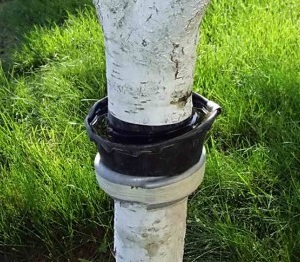 Insects on an apple tree not only spoil the fruit, but also eat leaves on the tree. Here are the main pests:
Insects on an apple tree not only spoil the fruit, but also eat leaves on the tree. Here are the main pests:
- apple blossom tree;
- codling moth;
- californian shchitovka;
- apple sawfly;
- red fruit mite;
- green apple aphid;
- five types of leaflets;
- american white butterfly;
- apple moth.
If you are interested in the topic "Pests of apple trees and the fight against them," you will find a photo of each of the above listed below.
Apple eatery
Insect apple flowering beetle from the family of weevils, beetle, feeds on swollen flowering buds apple trees. A bug of small size and incomprehensible blackish-brownish tone. Eggs are inside flowering buds.
The larval form, gnawing a flower inside, dazzles it with its own secretions, after that the flowers will not bloom and the harvest will not give. Flowering beetles are dangerous pests on apples (see photo below).
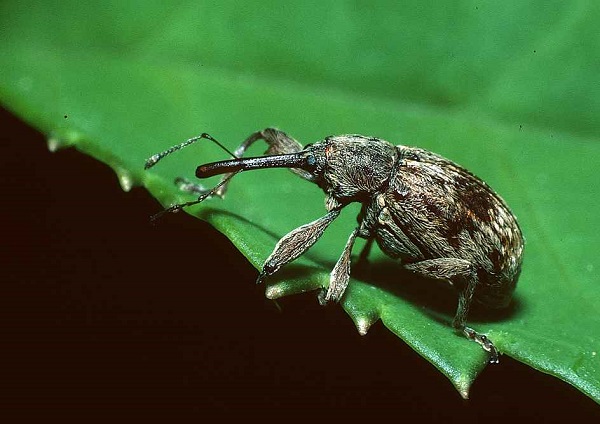
Apple Blossom.
Attention! The flower beetle can cause significant damage to the crop.
California shield
Insect Californian shchitovka damages not just an apple tree, but also other treesIn addition, in many areas of the Russian Federation, it is a quarantine insect pest.
An adult insect is similar to the tiny shell of a tortoise. And after its withering away, there remains a characteristic trace in the form ruby red spot with almost black center. These traces themselves are most noticeable on the bark of year-old twigs, apples, stipules.
Important!Wintering occurs as first instar larvae in irregularities of the bark of branches and small twigs.
After overwintering, the larvae, from the beginning of sap flow, vburavlivayas in young bark are covered with a protective cap. BUT at the beginning of June each female hatch up to 156 motile larvae. Who, scattering on a tree, start eating. And the second generation hatch at the end of August.
In the conditions of the extreme South, Kuban, the Crimean coast will be able to emerge by the end of October and the third generation, which goes into the winter. In the Black Earth only 1-2 generations.

Californian schitovka.
Aphid
Aphids are huge, both in their species composition and in their numbers, of a microscopic group of sucking, garden-damaging insects. Often, females hatch females and only at the end of the year, or when adverse weather sets in, aphids lay eggs to wait for bad conditions.
For aphids are characteristic huge fecundity, "omnivorous" and the maximum breadth of distribution. Excellent reproduction is noticeable in the summer wet, warm and when overdose easily absorbed by the roots of "organic" nitrogen. Then aphid on an apple tree is capable of giving up to 22 generations in a warm period.
And if time does not take action, it can cause the winter freezing of a young apple orchard.

Fruit mites
Fruit mites, especially red apple, like to suck out the juice from the leaves of apple trees, so that when they are multiplied excessively the leaves turn brown and fall off.
Such premature leaf fall is possible as early as July, in areas of the Non-Black Earth Region, or in August in the Kuban. He is sharp reduces the resistance of the tree to diseases and the upcoming winter cold, Because of this, trees may not survive the winter.
Red tick for apple trees most harmful. His eggs hibernate in the form of clusters in the cracks of 2-4 year old wood. Mites hatch in the "mouse ears" phase. The second generation is in the “rosebud” stage, and in the south there is also a third wave at the moment when the ovary is walnut. In summer, females are purple-scarlet, and they are brightly colored in the winter.
Like hawthorn mite this highlights gossamerwhich leaves the edges up when the number of mites on the tree is enormous.

Red apple tick.
Brown fruit mite
The brown fruit mite winters in the form of eggs on the branches under the buds of the buds, they are reddish themselves. With abundant breeding on the branches accumulates many larval covers from the previous molts, so that the twigs seem whitened by whitish dust.
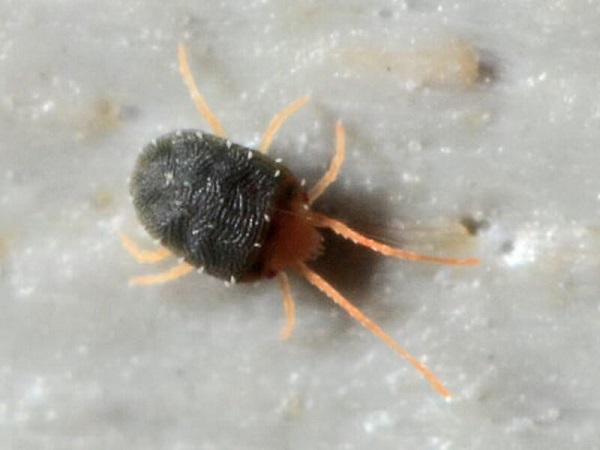
Brown fruit tick.
Sheet wrench
In recent years, leafworms cause increasingly sensitive harm to apple trees. They are very dangerous pests of apple trees (photos, their signs are given below).
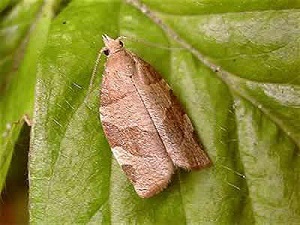 Most damaging for apple orchard will be:
Most damaging for apple orchard will be:
- willow;
- hawthorn;
- currant;
- omnivorous;
- kidney.
Caterpillars most willingly eat up its buds, leaves, buds, and even young ovaries. They overwinter in the stage of young caterpillars, in tiny, cobwebby-cotton-like cocoons or in the form of a cluster of eggs on young twigs of apple trees.
With hatching, the caterpillars, at the time of the green cone, and a large number of them are woven with a thin spider web and leaves and flowers. Pupating there, in June or in the first half of July butterflies fly out by august in the north of gardening, or by early September in the Kuban hatching tracks of the summer generation.
When they reach the second or third age, they crawl into the cracks of the bark of the tree, fall into a stupor and overwinter.
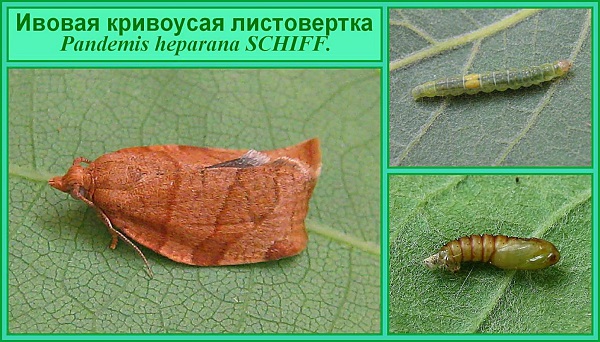
The wicker willow.
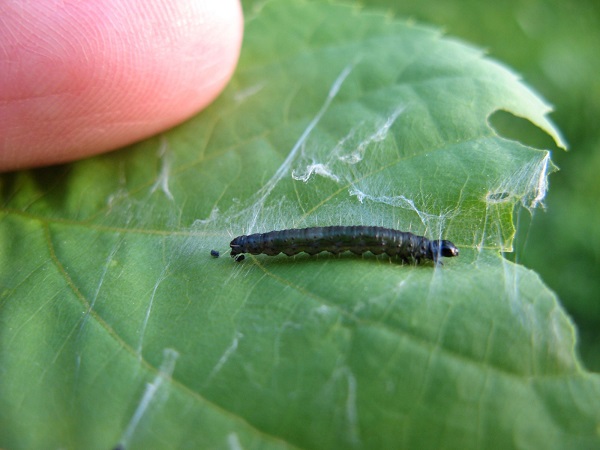
Hawthorn leaflet

Currant leaf wrap.
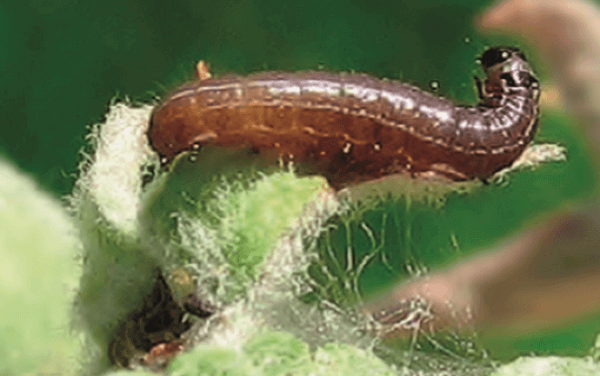
Kidney leaf worm.
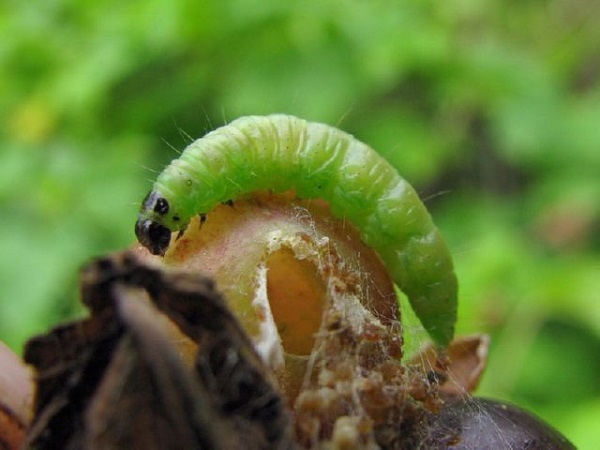
Shepherd is omnivorous.
Moth
Different types of insects, eating pulp apples or seeds, and called moth moths are distributed almost everywhere and able to spoil more than 2/3 of the crop.
Most often, the apple tree moth settles on the apple tree, hibernating in the cracks of the old bark in the larval or caterpillar phase of an older age in the web leaf cocoon.
Its wintering place may be on chatals, wooden struts and palmettes. Departure of butterflies begins immediately after the flowering of the garden.
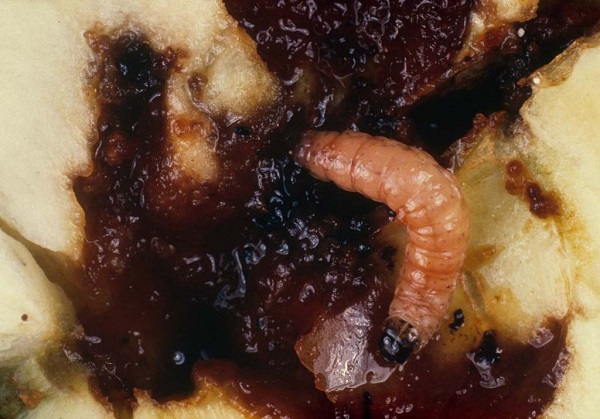
The moth is apple.
Important!One caterpillar born of the testicle can ruin up to 5 ovaries.
In the northern Nechernozemie they have one generation, and in the South and Kuban up to three full generations. And the eastern moth in the South is able to give five generations.
American white butterfly
Another quarantine pest of apple orchards is an American white butterfly. It hibernates, in the pupal stage, a butterfly in heaps of garbage, traces of tare, and warming material. The flight takes place from the beginning of May to mid-June.
The caterpillars feed on, twine around the leaves with a silvery thin spider web, forming a nest, and up to the third molt, the caterpillars feed on it. Then they crawl away and eat the leaves alone. There may be three generations in the Kuban, two to the north.
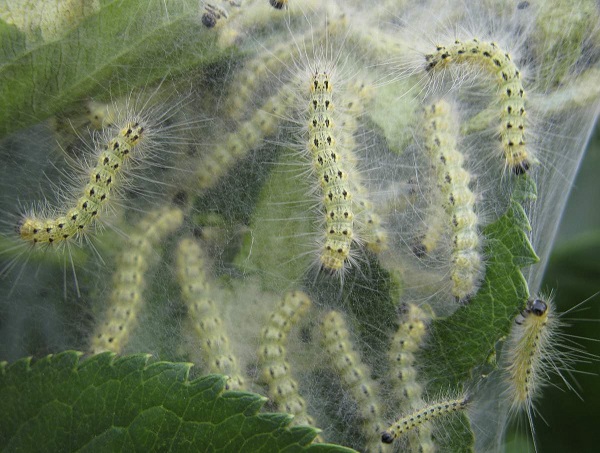
American white butterfly.
Apple Mole
Pests of apple leaves are also dangerous and the most dangerous mole apple. Development begins spring before flowering, and the places of caterpillar aggregations form large Kubla in a powerful whitish web with part of the twigs and leaves.
Develops in one generation, winters in the form of testicles, with outbreaks capable of destroying all the leaves on the apple trees.
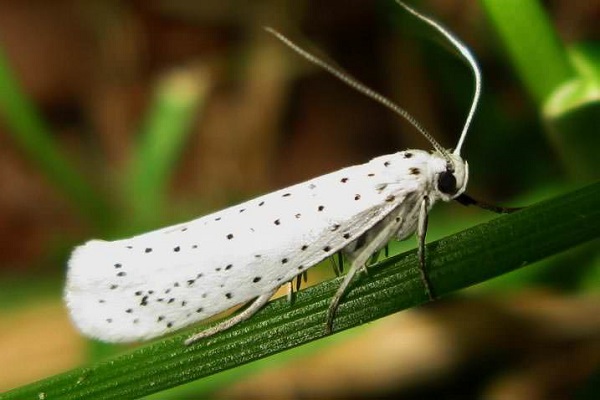
Photo of an apple moth.
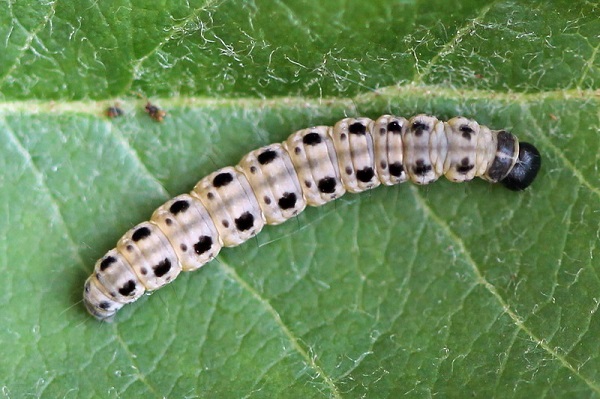
Apple moth in the caterpillar stage.
Protecting Apple from Disease and Pests
In order to stop the spread of viruses, contagious diseases and various caterpillars, pest protection.
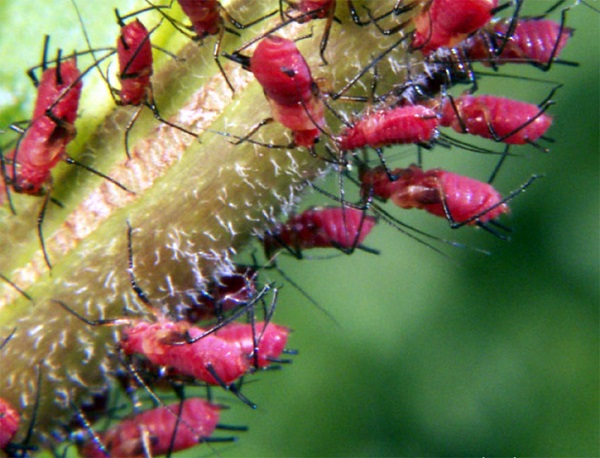
Diseases and pests of apple trees and the fight against them (photo of blood aphids).
Exists a whole range of activitieshow to get rid of pests on the apple tree. Besides agrotechnical and mechanical apply spraying with poisonous mixtures against aphids and sucking mites, because they are carriers of viruses and rot. For this method is used insecticides, permitted for trade and use by the public.
In row spacing and circle trees destroy weed vegetation, replacing with the necessary sodding. They cut the shoots, impose trapping belts on the trees, hang traps, lay mulch, only in the south, on the soil of the pristvolny circles.
Trimming, remote pest nests, carrion and dead leaves burn immediatelyas soon as such "garbage" appears.
In the summer
Tip! Preparations should be bought only in specialized places!
Summer Fight Begins immediately after flowering. Apple pests and the fight against them in the summer - the main points:
- sprinkling bordeaux Blend or special fungicides for scab trees (doses strictly according to instructions) three times with a break of 3 weeks;
- sprinkling apple trees tick mixtures (2 per season);
- if apple tree plantations are affected by the sawfly, they coat branches and boughs with a solution containing chlorophos;
- careful brushing the ovary and their subsequent burning from the apple: diseases and pests still damaged it;
- weekly inspection apple trees and destruction spider nests with caterpillars, and their burning;
- treatment from caterpillars after flowering held 2-3 times with an interval of 7 days;
- overlay "Trapping belts" on apple tree strands and their burning at the moment of apple filling;
- pruning shootscolonized by aphids and their burning.

Diseases and pests of apple trees and their treatment (photos of flowers damaged by weevil).
Attention!Using ready-made poison from the store, strictly adhere to the recommendations for its use, and if there is little information on the label, ask for help to the Internet.
Bark beetle
You can still save the apple tree if you noticed in time that you have a bark beetle on an apple tree - methods of struggle: to exits, bitten by bugs, with a syringe with a thin needle do an injection "Drug."
Solution Met  athosa or Chlorophos or Karbofos It is injected a little and usually 4-5 times, then the holes must be sealed with clay or wax.
athosa or Chlorophos or Karbofos It is injected a little and usually 4-5 times, then the holes must be sealed with clay or wax.
How to deal with bark beetle on an apple tree, if it damaged them badly? All apple trees, heavily eaten by bark beetles, need cut down and burn, as well as fragments of branches and twigs, pieces of the measles, to be thrown from the site and burned there, and the stumps burned out.
A decisive fight against the bark beetle on an apple tree will make it possible to get rid of this harmful insect in the garden.
Green midges
Often these small green midges on an apple tree - aphid. And it is for the war with aphids on apple trees that the application of n e poisonous means. For example:
- trimming the tips of the branches with aphids colonies;
- no use of manure and guano in top dressing;
- balanced nutrition of apple trees, including dressing with microelements.
If aphid has already appeared, then ants are killed simultaneously, otherwise the struggle is meaningless. To fight it with aphids, bitter pepper infusion or tobacco decoction will help. But if the number of "midges" is huge, then use synthetic poisons.
Tip! Do not use poisons a week before picking ripe apples!
Flowerbird
![]() Another small but very dangerous bug is a weevil. He likes to make money the flesh of the still not blossoming flowers of the apple tree. And if you do not kill him, then he able to destroy most of the "apple harvest."
Another small but very dangerous bug is a weevil. He likes to make money the flesh of the still not blossoming flowers of the apple tree. And if you do not kill him, then he able to destroy most of the "apple harvest."
And without the use of chemical drugs, war, with sabotage beetles on apples, is not productive.
Understanding how dangerous a flower beetle on an apple tree is, how to deal with it? For the extermination of overgrown beetles, tsvetoyedov use poisons "sistemnik" at the time of the budding of all the kidneys.
The current poisons do not affect the eggs and larval stages of this pest. Because the secondary processing of apple trees is still necessary. And better in July. In order to reduce the number of bugs, until they took shelter in the fallen leaves, the cracks of the bark, the root zone for winter rest.
For the extermination of tsvetoyorad good to use Malathion. They are sprayed with a 10% solution at the time of the "green cone". More effective will be the preparations for sprinkling trees, containing, as the main substance, the following compounds:
- Thiamethoxam;
- Deltamethrin;
- Dimethoate;
- Imidacloprid;
- Lambda-cyhalothrin.
Web
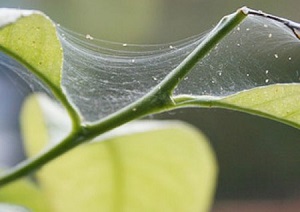 A web on an apple tree, which the spiders weave on an apple tree, is completely harmless and differs in the absence of impenetrability and openwork weaving.
A web on an apple tree, which the spiders weave on an apple tree, is completely harmless and differs in the absence of impenetrability and openwork weaving.
If snow-white, grayish, whitish-yellowish bunches of cobwebs on the ends of the branches with leaves in the middle were formed on the trees, then this is a “work” harming caterpillars.
Kohl does not begin prompt action to eliminate them, the fruit from the apple trees can not wait, or they will become wormy and rotten. There are no difficulties in the war with such pests that they “give birth” to the spiderweb on the apple trees.
The main thing here - in a timely manner to determine what is this pest and immediately eliminate it. In addition, it is necessary to comprehend what actually became the primary cause of the burst of pest moths on the shoots of apple trees.
If it appeared apple moththen necessary destroy the "network" her, resolutely on all parts of the apple tree, where you can reach.
Definitely need eliminate caterpillars, simultaneously with their “spider houses” in the crown of a tree, sprinkling trees with poisons, using preparations containing:
- Carbosulfan;
- Alpha-cypermethrin;
- Dimethoate;
- Cypermethrin.
Shchitovka
 If a gravel is found on an apple tree - how to fight? When identifying insects on the tree, the insects should be at the time of continuous emergence of strollers (June and August) spend sprinkling infected apple trees, any insecticide.
If a gravel is found on an apple tree - how to fight? When identifying insects on the tree, the insects should be at the time of continuous emergence of strollers (June and August) spend sprinkling infected apple trees, any insecticide.
The best drugs for war with flaps are:
- Dimethoate;
- Chlorpyrifos;
- Thiacloprid;
- Chlorpyrifos.
For greater strength of victory, processing is allowed to be done once again with an interval of five days, replacing the pesticides used in this treatment.
The number of shchitovki reduce and spring sprinkling of trees apple trees from leafworm in the end of April, At this time, moltings live at the shield insects, and they die from this sprinkling, but the substances of the poisons are the same.
Ognevka
Many gardeners think that if the tips of the branches of apple trees are entwined with a delicate web, then a pest appeared on the apple tree - how to deal with this scourge? Do not hurry, there is no real fire on the apple tree, but only on berry bushes.
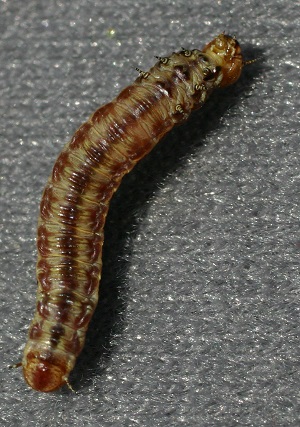 Often densely bedokurit on apple trees apple moth or similar types of moles, so they are confused with fire spells. And they can really spoil everything and everyone in the apple orchard.
Often densely bedokurit on apple trees apple moth or similar types of moles, so they are confused with fire spells. And they can really spoil everything and everyone in the apple orchard.
You can fight moles both chemically and mechanically and agrotechnically.
Chemical method of war - this is the treatment with preparations of the tree crown, containing one of the types of such compounds as:
- Lambda cyhalothrin;
- Carbosulfan;
- Alpha-cypermethrin;
- Dimethoate;
- Cypermethrin;
- Permethrin.
AND mechanically It is possible - it is catching on traps, or the removal of leaf-nests and hilling with organic matter of the trunk of a trunk, in early spring (the leaves have already turned), 7 cm thick.
BUT agrotechnicallyThis is the maintenance of large quantities of predatory beneficial insects in the apple orchard, and the tree is unnecessarily poisoned.
Apple Mole
Apple moths can leave the garden without a crop. In small gardens, cobweb "nests" of the moth of the apple tree and its "relatives" are knocked down from the branches of trees and burned. And if more than 7 cobweb "nests" are found, on the first tree of the apple tree, it is better to apply special preparations with moth caterpillar poison.
In apple orchards, treatment against the moth is started as soon as the stormy bloom ends. And drugs either Bitoxibacillinand if there is no such thing, then only synthetic poisons containing one of such compounds as:
- Dimethoate;
- Cypermethrin;
- Permethrin;
- Chlorpyrifos sprayed on the crown of the tree.
Mice
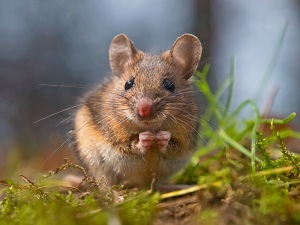 Mice dangerous young apple trees. At the tree bark of trunk and twigs are tasty and not coarsened. And if you make it inedible, then the mouse will not be dangerous to the garden. Let's figure out how to protect the apple trees from mice in the winter.
Mice dangerous young apple trees. At the tree bark of trunk and twigs are tasty and not coarsened. And if you make it inedible, then the mouse will not be dangerous to the garden. Let's figure out how to protect the apple trees from mice in the winter.
As a barrier to do protective windings for the bark of apple trees. For example, polypropylene mesh bags from vegetables and scotch. Or, using an unnecessary woolen cloth, wrap a bole, a part of a trunk and a part of young branches of a tree in a couple of layers, about a meter.
It is good to use and torn nylon women's tights for wrapping trunks of apple trees from roasting.
Tip!An excellent alternative would be Agrofibre. It itself serves many seasons, comes out cheap, and for protection, even in a torn state, trees from mice will not yield to anyone.
Young apple trees can be defended with ordinary plastic bottles and bottles. They cut out the "hollow parts", cutting off the neck and bottom, and cut them along. This plastic case is put on the stem of the apple tree and wrapped with thin wire or tape to secure. On the bark of the stem of a tree, first wound white paper and a bottle on it.
Still, the trunk is covered with something prickly inedibleFor example, spruce branches with winding pieces of polyethylene.
Green bugs
You noticed some green bugs on an apple tree. If this is not just adult, mature individuals of aphids with wings on apple leaves, taken by many summer residents as “green bugs”, then this can be green beetle beetle.
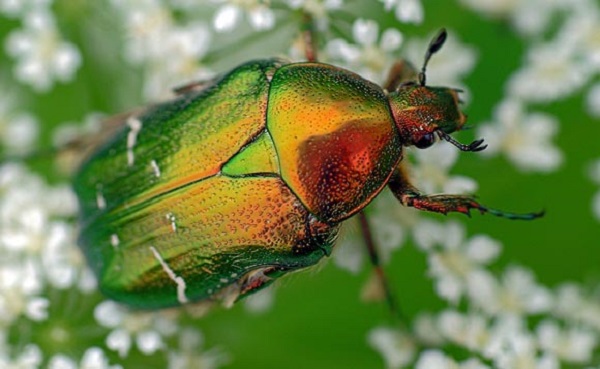
Bronze beetle.
Himself an adult, flying, bug not scary. Terrible him larval stages, hefty, thick and milky-colored, like a grub, larvae. They are extraordinary insatiable and eat the roots of apple trees and even rhizomes in lawn grasses.
Fight them only insecticides. The safest of the soil poisons for summer residents will be the drug Aktara.
Whitefly (butterfly)
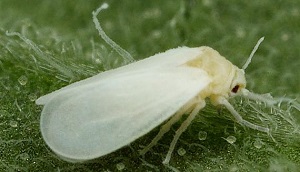 Butterflies dangerous in the trees only at the moment of "flash". They are able, in the form of caterpillars, to destroy apple leaves by ¾. This not only deprives the tree of the crop, but, weakening it, will allow the frost in the winter to kill such an apple tree.
Butterflies dangerous in the trees only at the moment of "flash". They are able, in the form of caterpillars, to destroy apple leaves by ¾. This not only deprives the tree of the crop, but, weakening it, will allow the frost in the winter to kill such an apple tree.
This whitefly on an apple tree is very unpleasant, how to deal with it? In country and private peasant gardens, allowed use poisons containing in its composition:
- Deltamethrin;
- Thiacloprid;
- Thiamethoxam.
You should not chase with the sprayer, for one butterfly in the garden. But it is extremely harmful to delay the treatment of trees, it will be better to carry out the first treatment with the adhesive at the first signs of the cobweb on the leaves. But it is possible to carry out the early-spring processing with a soap-and-oil emulsion, on bare trees.
The processing time of the season
Spring time spraying trees from sap flow up to the tree and before the budding begins. And right after it ends.
 Pest control of apple trees in the summer is as follows: splashing trees from the appearance of the ovary the size of a hazelnut and before the start of the coloring sprinkle the crowns of trees. It is not advisable to use poison at the very end of the ripening of the crop.
Pest control of apple trees in the summer is as follows: splashing trees from the appearance of the ovary the size of a hazelnut and before the start of the coloring sprinkle the crowns of trees. It is not advisable to use poison at the very end of the ripening of the crop.
In the autumn pests are poisoned on trees from the time of harvesting apples from an apple tree to the first frost at -5 degrees. You can carry out the destruction of insects on the tree and after leaf fall.
More information about this can be obtained from this section.
Chemical control methods
When your apple trees are completely covered with pests of the apple tree and the struggle with them with folk remedies does not help, heavy artillery comes to the rescue - chemicals.
Attention! Chemical compounds need to be changed during apple treatments, so that insects do not accumulate resistance to them!
From moth
For "early trees" enough 2 treatments autumn apple trees require 4 times spraying, and winter apples are sprayed to 5-6 times. Substances less dangerous to humans, but poisons, for butterflies and caterpillars:

- Deltamethrin;
- Alpha-cypermethrin;
- Thiacloprid;
- Lufenuron;
- Thiamethoxam;
- Lambda-cyhalothrin.
From aphids in summer
In the summer it is very important and the treatment of apple trees from aphids is necessary, especially if overdosing nitrogen. In the summer good help synthetic poisons following names:
- Thiamethoxam;
- Thiacloprid;
- Carbosulfan.
All the most important about you can learn from this section.
From worms
If these are “worms” in apples, then this moth larvae, if on leaflets, then this leaf wrappers or sheet rats. Therefore, they are destroyed according to the processing data given here.
Read more about the fight here.
From the leafworm
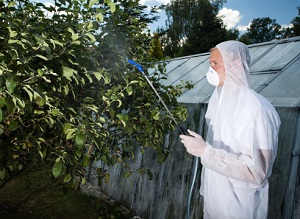 Processing of apple trees only chemistry from the leafers and the best connections are:
Processing of apple trees only chemistry from the leafers and the best connections are:
- Lambda cyhalothrin;
- Carbosulfan;
- Alpha-cypermethrin;
- Dimethoate;
- Cypermethrin;
- Permethrin;
- Chlorpyrifos.
For information on what to fight without harm to the crop, read this article.
From ants
The best prevent aphid outbreaks on an apple tree, and as a result, the appearance of a large number of ants. But if they appeared, then you can poison them just under the trees and only compounds such as dimethoat and diazinon.
Read more about how to fight in this article.
From tracks
Caterpillars of different ages destroy only "system men" sprinkled on the crown of the tree. Of all known poisons, the safest for the garden, and poisonous for caterpillars, will be:
- Carbosulfan;
- Alpha-cypermethrin;
- Dimethoate;
- Cypermethrin;
- Permethrin;
- Chlorpyrifos.
About the most effective measures of struggle described in this article.
From tick
 Fruit and leaf mites require specific poisons. Of all sold most quickly and efficiently destroy ticks:
Fruit and leaf mites require specific poisons. Of all sold most quickly and efficiently destroy ticks:
- Permethrin;
- Pyrimiphos-methyl;
- Chlorpyrifos.
Useful videos
Look at the video for more interesting pests and means of combating them:
From this video you will learn how to deal with the moth:
This video describes how to deal with aphids:
And this video tells you how to spray an apple tree from a flower eater:
Conclusion
Now you know what the main pests are on the apple tree, how to fight them. WITH timely and correct work for the destruction of insects that harm apple and for the treatment of diseases, will allow you to enjoy delicious apples and will not let the apples die from the winter cold.
In order not to lose the war with the enemy, you need to know what apple pests look like (photos, signs), watch a video about fighting them. Then the garden will thank you.
And knowing exactly what your apple tree is affected with (diseases and pests - their photos are given above), you will be able to find the best way to fight.
Apple trees belong to garden trees, which require close attention throughout the year. Most gardeners have several varieties of apple trees, which differ in terms of fruiting and protective properties.
Garden pests can affect apples, regardless of the variety, which always affects the quality of the crop and its size. Preservation of productivity is promoted by knowledge of the main pests of apple trees, the periods of their activity and effective methods of protection against them.
The main pests of apple trees
Before starting the mass destruction of the pests that appeared on the apple tree, it should be clarified what kind of species settled on the fruit tree. The choice of the method of struggle, its effectiveness and the final result will depend on this.
Brown fruit mite
It can damage any fruit trees, but the main food plant is an apple tree. The body of an adult individual is brown in color and is 0.5 mm long. The tick is moved by four pairs of legs. Lays very tiny and round eggs of red color. The active laying period occurs in the summer and autumn. Larvae hatch during bud break. Five generations are developed over the year.
The larvae and adults feed on the juice of the kidneys and foliage, which as a result become covered with an off-white bloom and completely cease to develop.
The main methods of control are spraying: in early spring with 1.5% DNOC, and during the growing season with 0.2% carbofos.
Leaf eaters
Caterpillars and beetles, which eat the green mass of horticultural crops, cause significant damage. They can feed on buds, ovaries, foliage, buds and flowers. This type of pest includes sow dwarfs, hawthorn, Leechworms, goldfinder, as well as the larval stage and caterpillars of the winter moth, ringed silkworm, apple mills and apple moth.
This pest is a small black-brown bug. It has light stripes and arched proboscis. The wintering places of this weevil are the folds of bark and  fallen leaves. With the beginning of spring, the flower beater gets over to a tree, where it begins to actively feed on buds. Females perform egg-laying directly into flower buds. Hatching larvae destroy the bud completely.
fallen leaves. With the beginning of spring, the flower beater gets over to a tree, where it begins to actively feed on buds. Females perform egg-laying directly into flower buds. Hatching larvae destroy the bud completely.
Flowers on the apple tree are transformed into dark caps stuck together by excrement, which do not open and do not bloom.
If you want to enjoy a rich harvest of carrots, then you need to know how to protect the plant from pests. To do this, we recommend reading the material on the link.
This pest destroys mainly the fruit of the apple. Females immediately after flowering 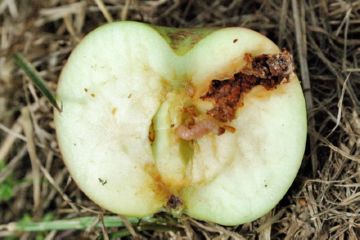 perform egg-laying. It takes about two weeks to hatch the caterpillars, after which it penetrates into the center of the fetus and gradually moves to the next fetus. Adult caterpillars winter in cocoons. The most dangerous are the second and third generation pests. Butterflies appear before flowering, and the period of active flight can last for two months.
perform egg-laying. It takes about two weeks to hatch the caterpillars, after which it penetrates into the center of the fetus and gradually moves to the next fetus. Adult caterpillars winter in cocoons. The most dangerous are the second and third generation pests. Butterflies appear before flowering, and the period of active flight can last for two months.
In order to destroy the codling moth, it is necessary to process the summer apple varieties twice per season, and spray the winter varieties at least three times. The first treatment is made immediately after flowering, and repeated - after two weeks. A good effect is achieved by using 80% chlorophos.
For me, there has always been only one apple pest, this is a worm. I used to bite an apple in my childhood, and from there the indignant worm looks. Always joking, it means apple is delicious. This, of course, may be so, but it is pitifully regrettable if many of the fruits on the branches actually perish. Only I thought that one spraying was enough, but it turns out that everything depends on the sort of apples.
Hello, in our garden area, I also came across with pests of apple trees, and more precisely, with glass butterflies. I noticed that they mainly hit the bark of trees. This is reflected, not in the best way, and on the fruits of the apple tree. Tell me, what is the best time to process apples? And which drugs are the most effective in the fight against glass moths with butterflies?

